|
|
Six observers in Australia recorded positive results for this event.
View the updated predictions..
Observers: 1 G Bolt,Perth, WA, AU - Time series photometry 2 S Kerr,Glenlee, Queensland, Australia - Video 3(C) J Bradshaw,Samford, QLD, AU - Video 4 P Anderson,Taylor Range Obs, QLD,AU - Visual 5 J Brougton, Reedy Creek, QLD, AU - CCD 6 D Gault,Hawkesbury Heights, NSW,AU - Video 7 T Dobosz,Bankstown, NSW,AU - Video Thanks to all the observers who sent in their detailed raw data.
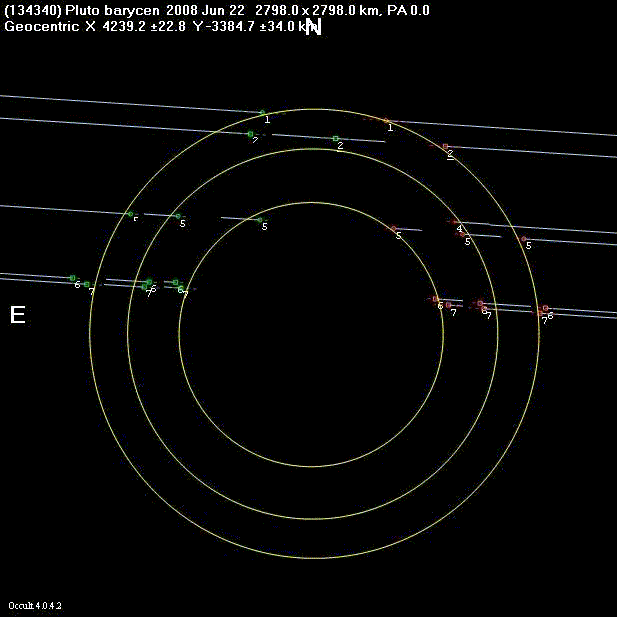
Discussion: The Plot above shows 3 "layers" in Pluto' atmosphere. The outer ring is roughly at the 95% light point, the middle ring 50% light, and the inner ring 5% light. The inner ring is drawn at the expected diameter of 2,306 km for 50% point. and the fit to observed points is good.
The process to achieve this analysis is described below.
The data presented here has been normalised so that all the data is in relative Linear Flux (intensity) units rather than Magnitude (log scale) to try to get a better picture of what had been seen.
A Sliding Average Filter was then used on the data that had been Video recorded using a 1 or 3 second average.
Steve had a very strong 3 sec "beat" showing in his data so a 3 second average was used to null that frequency out.
The beat was probably caused by light polution with a 50Hz or 100Hz frequency beating (hetrodyning to use the radio term) with the 50Hz field rate of the video camera.
For data with longer sampling periods a 1 minute average was used.
Sliding Average Filters have excellent Time Domain response when measuring the 50% point but complex frequency domain response, and in particular can be tuned to largely eliminate periodic noise.
By using a sliding average rather than just one average every x seconds it is easy (and accurate) to estimate the 50% point to within a few of the original sample periods (frame or field in the Video case) despite the presence of noise, down to where S/N is about 0.5 or sometimes better. This makes it feasible to pick out the 50% point on the curves or, for Greg and Steve, to be sure they did not get down to the 50% point but to be able to estimate their minimum point quite accurately.
Approximations for the 5% (above the base of curves that had a "flat" bottom), to get a feel for where the path was just above the "surface", and the 95% points for all curves to get a feel for where the upper edge of Pluto's atmosphere may be were made.
The accuracy of the 5% and 95% estimates is much poorer than for the 50% points as the Sliding Average filter biases the times.
Since the observations were at low elevation angles the change in atmospheric extinction over the several minutes of observing is likely to at least partially explain why the unocculted before and after levels are a bit different. No attempt has been made to correct for this effect.
For the plot above the smaller circles have been pasted over the 95% one so that we can see how they relate. Clearly they are not as concentric as one would hope but you will get a feel for what we are looking at and can also see a rough estimate of the varaiance between the estimates of the actual center path.
I am sure that Bruno Sicardy will have much more detailed and scientifically more accurate results in due course.
All in all I would say a very satisfactory set of results - well done team.
View video of Dave Gault's observation
The figures below show the lightcurves of the occultation where time series data was available.
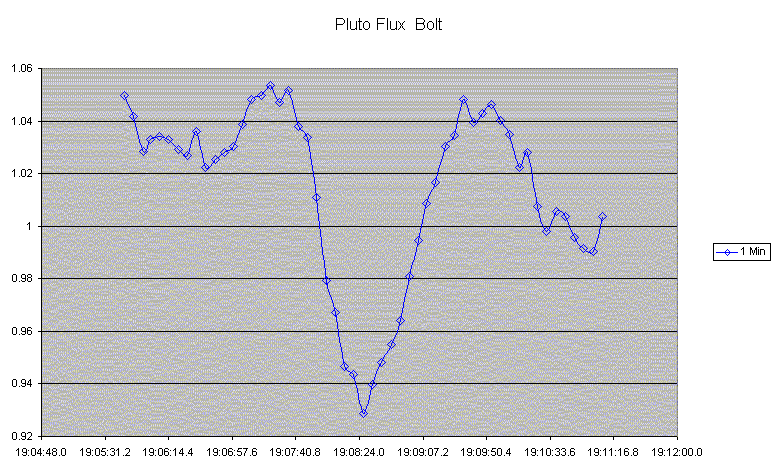
Pluto light curve - Bolt. Note very small actual drop.
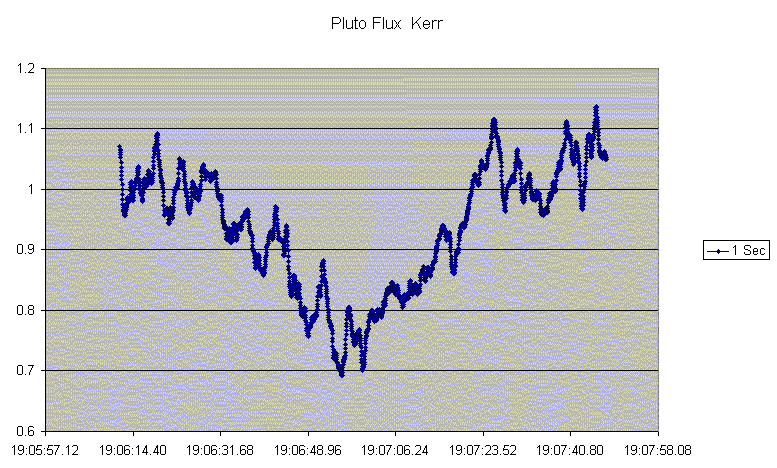
Pluto light curve - Kerr. Again only a partial drop.
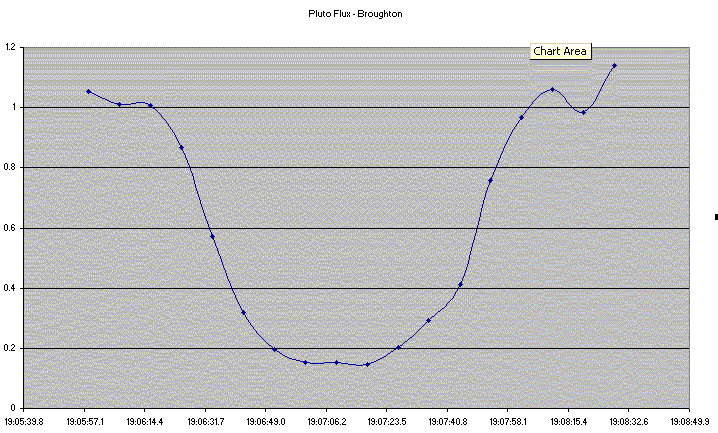
Pluto light curve - Broughton.
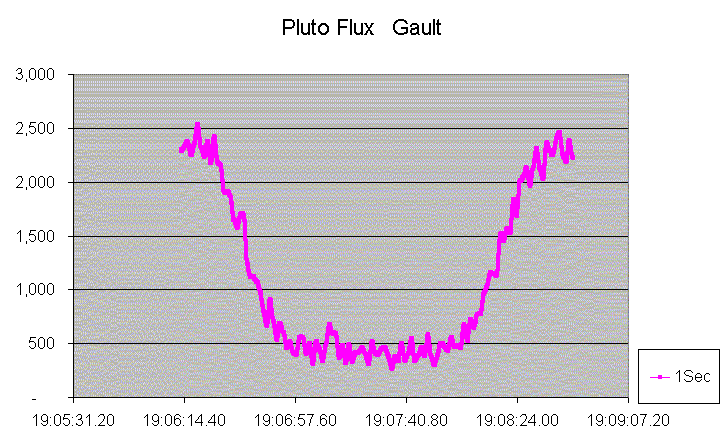
Pluto light curve - Gault. This curve is highly symetrical and correlation of some small steps on each side can be seen.
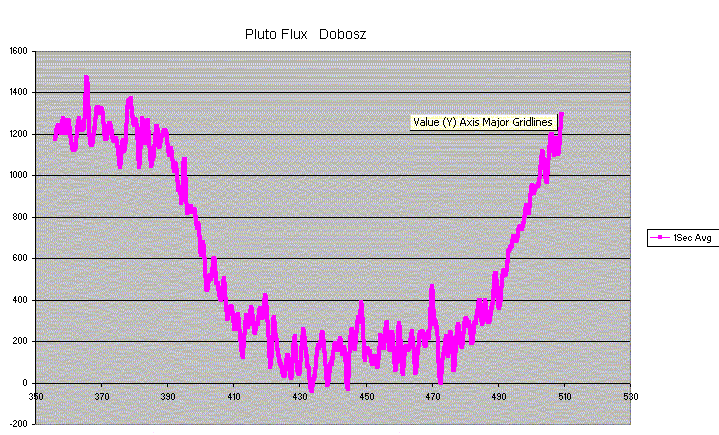
Pluto light curve - Dobosz.
Observational Data:
Observation details for MP (134340) Pluto By Star UCA 2U25370799 On 2008-06-22 at 19:08:00.0 Note times reported below are the original observations - not the adjusted times used in the plots above. _______________________________ Observer Greg Bolt Location Perth Longitude +115:45:31.3 Latitude -31:47:21.5 Altitude 45 m Datum WGS84 Telescope SCT including Cass and Mak Aperture 25 cm Seeing Slight flickering Clear Timing other Video, photo or photoelectric Disappearance 19:08:39.00 Reappearance 19:08:58.00 Comments: This was a time series photometry session on the target star. Images had an exposure time of 2 seconds, with a download time of 4 seconds between images. There is a hint of an event around 19:08:27 where the magnitude drop maybe around 0.05. _______________________________ Observer Stephen Kerr Location Glenlee, Queensland, Australia Longitude +150:30:0.8 Latitude -23:16:9.6 Altitude 50 m Datum WGS84 Telescope SCT including Cass and Mak Aperture 30 cm Seeing Strong flickering Clear Timing GPS - time inserted Video with frame analysis Disappearance 19:06:40.00 Reappearance 19:07:24.00 Comments: Video camera integrating with a exposure period of 120ms. Detailed Limovie analysis from 18:35 to 18:37, 18:43 to 18:45, 18:58 to 19:00, 19:05 to 19:09 (see attached), 19:13 to 19:15, 19:29 to 19:31 and 19:37 to 19:39. _______________________________ Observer Peter Anderson Location Taylor Range Observatory Longitude +152:55:54. Latitude -27:27:48. Altitude 176 m Datum Other Telescope Newtonian Aperture 41 cm Seeing Slight flickering Clear Timing Tape Recorder + time signal Visual, PE applied Disappearance 19:06:35 Reappearance Missed Comments: Bright moonlight and low altitude Comments on tape: (Comparing target star with adjacent comparison star) _______________________________ Observer Jonathan Bradshaw Location Samford, Queensland, Australia Longitude +152:52:22.7 Latitude -27:21:22.8 Altitude 95 m Datum WGS84 Telescope Dobsonian Aperture 50 cm Seeing Strong flickering Star faint Timing GPS - time inserted Video with frame analysis Missed Comments: It all went horribly wrong! The conditions went from perfect to dreadful overnight, and by the time of the event everything was a blur. The target was only 13 degrees high, and right on my horizon to the west. The video shows nothing, and it is quite possible that I wasn't even pointing at the right place anymore. One to forget!!! _______________________________ Observer John Broughton Location Reedy Creek, QLD, AU Longitude +153:23:52.8 Latitude -28:06:30.3 Altitude 66 m Datum WGS84 Telescope SCT Aperture 25 cm Seeing Steady Clear Timing Tape Recorder + time signal + shutter CCD images at 3s intervals Disappearance 19:06:32.10 Reappearance 19:07:50.30 Comments: : CCD images were taken at a rate of 20 frames per minute. CCD images were taken at a rate of 20 frames per minute. Each point on the lightcurve represents a stack of 3 frames. The times were calculated for the half-light level in Pluto's atmosphere and based on an audio recording of shutter events and a time reference calibrated to UTC, just as I do for drift-scan timing. _______________________________ Observer Dave Gault Location Hawkesbury Heights Longitude +150:38:27.8 Latitude -33:39:52. Altitude 286 m Datum WGS84 Telescope Newtonian Aperture 25 cm Seeing Steady Clear Timing GPS - time inserted Video with frame analysis Disappearance 19:06:27.50 Reappearance 19:08:26.50 Comments: Camera was a Watec WAT-120N, set at 32 frame integration. Reported time is for the first detection of light drop caused by Pluto's atmosphere. Light curve included with report _______________________________ Observation details for MP (134340) PLUTO By Star UCA 2U25370733 On 2008-06-22 at 19:06:00.0 _______________________________ Observer Ted Dobosz Location Bankstown, NSW,AU Longitude +151:01:26.9 Latitude -33:55:33.5 Altitude 25 m Datum WGS84 Telescope SCT including Cass and Mak Aperture 28 cm Seeing Strong flickering Star faint Timing GPS - time inserted Video with frame analysis Disappearance 19:06:41.00 Reappearance 19:08:17.00 Comments: Significant Pollution present. Integrations of 32 frames I.E. 1.28 secs The disappearence and reappearence times are estimates based on first apparent trend of COMMENCEMENT of dimming and first apparent FULL re-appearance --->